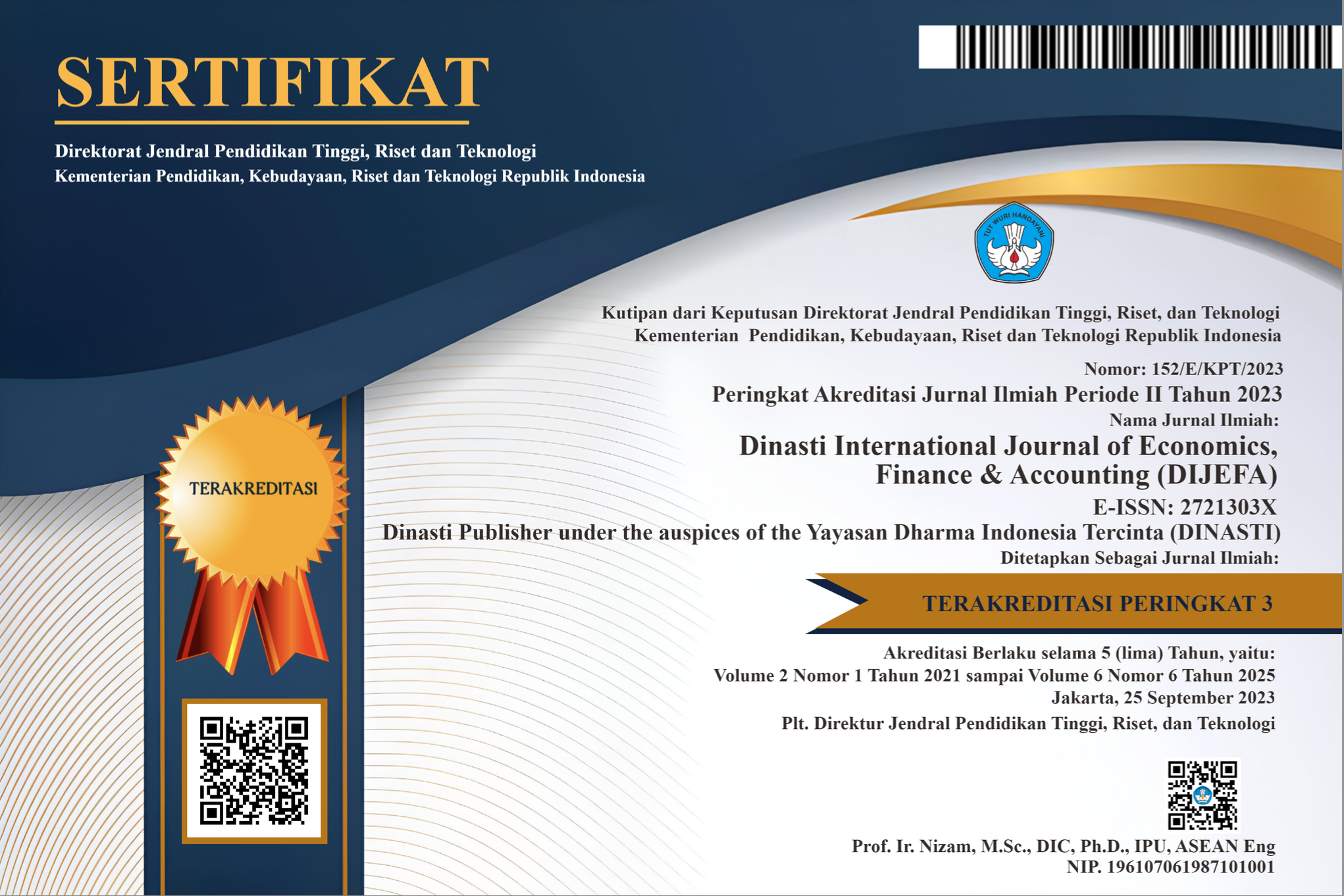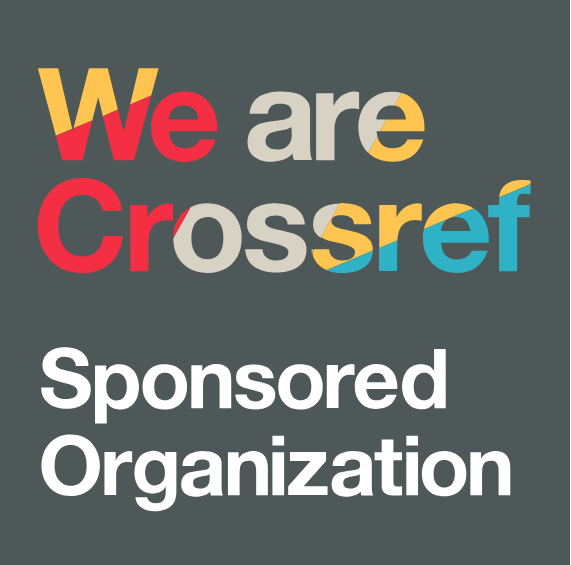Navigating Industry 4.0: The Strategic Role of Dynamic Capabilities in Transforming Indonesian Manufacturing
DOI:
https://doi.org/10.38035/dijefa.v6i2.4549Keywords:
Dynamic capabilities, Industry 4.0 capabilities, Manufacturing companies PLS-SEMAbstract
Incorporating industry 4.0 technologies into manufacturing operations is hindered by significant organizational and managerial challenges. This research addresses the problem of insufficient organizational and managerial strategies in embracing industry 4.0 within Indonesian manufacturing companies. Utilizing a quantitative approach, data was collected through a survey distributed among Indonesian manufacturers. The collected data was analyzed using PLS-SEM to identify the critical factors influencing successful Industry 4.0 integration. The findings highlight the critical role of dynamic capabilities – sensing, seizing, and reconfiguring – in enhancing Industry 4.0 capabilities. By fostering these dynamic capabilities, companies can effectively integrate Industry 4.0 technologies, leading to increased competitiveness and operational efficiency within the Indonesian manufacturing sector. This study offers valuable insights for managers and policymakers as they navigate the challenges of Industry 4.0 and build a robust manufacturing ecosystem in Indonesia.
References
Aghimien, D., Aigbavboa, C. O., Oke, A. E., Edwards, D., Thwala, W. D., & Roberts, C. J. (2022). Dynamic capabilities for digitalisation in the AECO sector – a scientometric review. Engineering, Construction and Architectural Management, 29(4), 1585–1608.
Agostini, L., & Filippini, R. (2019). Organizational and managerial challenges in the path toward industry 4.0. European Journal of Innovation Management, 22(3), 406–421. https://doi.org/10.1108/EJIM-02-2018-0030
AL-Khatib, A. W. (A). (2023). The impact of Industry 4.0 capabilities on operational performance: the mediating effect of supply chain ambidexterity. The TQM Journal. https://doi.org/https://doi.org/10.1108/TQM-06-2023-0193
AL-Khatib, A. W. (B). (2023). Internet of things, big data analytics and operational performance: the mediating effect of supply chain visibility. Journal of Manufacturing Technology Management, 34, 1–24. https://doi.org/10.1108/JMTM-08-2022-0310
AL-Khatib, A. W., Shuhaiber, A., Mashal, I., & Al-Okaily, M. (2023). Antecedents of Industry 4.0 Capabilities and Technological Innovation: A Dynamic Capabilities Perspective. European Business Review.
Atiku, S. O., & Abatan, A. A. (2021). Strategic capabilities for the sustainability of small, medium, and micro enterprises. . Reshaping Entrepreneurship Education with Strategy and Innovation, 17–44. https://doi.org/10.4018/978-1-7998-3171-6.ch002
Chatterjee, S., Chaudhari, R., & Shams, R. (2023). Applications of industry 4.0 for pandemic responses and business continuity: a TOE-DCV integrated approach. IEEE Transactions on Engineering Management. https://doi.org/10.1109/TEM.2023.3250587
Cho, H. E., Jeong, I., Kim, E., & Cho, J. (2023). Achieving superior performance in international markets: the roles of organizational agility and absorptive capacity. Journal of Business and Industrial Marketing, 38(4), 736–750. https://doi.org/10.1108/JBIM-09-2021-0425
Dalenogare, L. S., Benitez, G. B., Ayala, N. F., & Frank, A. G. (2018). The expected contribution of industry 4.0 technologies for industrial performance. International Journal of Production Economics, 204, 383-394. https://doi.org/https://doi.org/10.1016/j.ijpe.2018.08.019
Deloitte. (2020). Industry 4.0 Readiness Report. Https://Www.Deloitte.Com/Za/En/Services/Risk-Advisory/Perspectives/Industry-4-0-Readiness-Report.Html.
Drydakis, N. (2022). Artificial intelligence and reduced SMEs’ business risks. A dynamic capabilities analysis during the covid-19 pandemic. Information Systems Frontiers, 24(4), 1223-1247.
Ellström, D., Holtström, J., Berg, E., & Josefsson, C. (2022). Dynamic capabilities for digital transformation. Journal of Strategy and Management, 15(2), 272-286. https://doi.org/10.1108/ JSMA-04-2021-0089
Eslami, M. H., Jafari, H., Achtenhagen, L., Carlbäck, J., & Wong, A. (2021). Financial performance and supply chain dynamic capabilities: the Moderating Role of Industry 4.0 technologies. International Journal of Production Research, 1–18.
Felsberger, A., Qaiser, F. H., Choudhary, A., & Reiner, G. (2022). The impact of Industry 4.0 on the reconciliation of dynamic capabilities: evidence from the European manufacturing industries. Production Planning and Control, 33, 277–300. https://doi.org/http://dx.doi.org/10.1080/09537287.2020.1810765
Fernando, Y., Wahyuni, I. S., Gui, A., Ikhsan, R. B., Mergeresa, F., & Ganesan, Y. (2022). A mixed-method study on the barriers of industry 4.0 adoption in the Indonesian SMEs manufacturing supply chains. Journal of Science and Technology Policy Management, Vol. 14 No. 4, 14(4), 678–695. https://doi.org/https://doi.org/10.1108/JSTPM-10-2021-0155
Garbellano, S., & Da Veiga, M. (2019). Dynamic capabilities in Italian leading SMEs adopting industry 4.0. Measuring Business Excellence, 23(4), 472-483.
Gupta, S., Modgil, S., Gunasekaran, A., & Bag, S. (2020). Dynamic capabilities and institutional theories for industry 4.0 and digital supply chain. Supply Chain Forum: An International Journal, 21(3), 139-157.
Hair, J. F., Risher, J. J., Sarstedt, M., & Ringle, C. M. (2019). When to use and how to report the results of PLS-SEM. European Business Review.
Hunt, S. D., & Madhavaram, S. (2020). Adaptive marketing capabilities, dynamic capabilities, and renewal competences: The “outside vs. inside” and “static vs. dynamic” controversies in strategy. Industrial Marketing Management, 89, 129-139.
Jantunen, A., Tarkiainen, A., Chari, S., & Oghazi, P. (2018). Dynamic capabilities, operational changes, and performance outcomes in the media industry. Journal of Business Research, 89, 251-257.
Laskurain-Iturbe, I., Arana-Landin, G., Landeta-Manzano, B., & Jimenez-Redal, R. (2023). Assessing the uptake of industry 4.0 technologies: barriers to their adoption and impact on quality management aspects. . International Journal of Quality and Reliability Management, 40(10).
Lepore, D., Vecciolini, C., Micozzi, A., & Spigarelli, F. (2023). Developing technological capabilities for Industry 4.0 adoption: an analysis of the role of inbound open innovation in small and medium-sized enterprises. Creativity and Innovation Management. https://doi.org/https://doi.org/10.1111/caim.12551
Ozen-Ozkan, Y. D., Kazancoglu, Y., & Mangla, S. K. (2020). Synchronized barriers for circular supply chains in industry 3.5/industry 4.0 transition for sustainable resource management. Resources, Conservation and Recycling, 161. https://doi.org/10.1016/j.resconrec.2020.104986
Paryanto. (2021). Industry 4.0 dan Kesiapan Industri Manufaktur di Indonesia. In J. U. D. Hatmoko (Ed.), Revolusi Industri 4.0 (Vol. 1, p. 33). Andi.
Piccarozzi, M., Aquilani, B., & Gatti, C. (2018). Industry 4.0 in Management Studies: A Systematic Literature Review. Sustainability. https://doi.org/10.3390/su10103821
Roblek, V., Meško, M., & Krapež, A. (2016). A complex view of Industry 4.0. Sage Open, 6(2). https://doi.org/10.1177/2158244016653987
Teece, D. J., Peterav, M., & Leih, S. (2016). Dynamic Capabilities and Organizational Agility: Risk, Uncertainty, and Strategy in the Innovation Economy. California Management Review, 13–35.
Teece, D. J., Pisano, G., & Shuen, A. (1997). Dynamic capabilities and strategic management. . Strategic Management Journal, 18(7), 509–533. https://doi.org/https://doi.org/10.1002/(SICI)1097-0266(199708)18:7<509::AID-SMJ882>3.0.CO;2-Z
Toorajipour, R., Sohrabpour, V., Nazarpour, A., Oghazi, P., & Fischl, M. (2021). Artificial intelligence in supply chain management: a systematic literature review. Journal of Business Research, 122, 502–517. https://doi.org/10.1016/j.jbusres.2020.09.009
Winter, S. (2003). Understanding Dynamic Capabilities. Strategic Management Journal, 24, 991–995. https://doi.org/https://doi.org/10.1002/smj.318
Wu, Q., Yan, D., & Umair, M. (2023). Assessing the role of competitive intelligence and practices of dynamic capabilities in business accommodation of SMEs. Economic Analysis and Policy, 1103–1114.
Downloads
Published
How to Cite
Issue
Section
License
Copyright (c) 2025 Novan Wahyudi, Arviansyah Arviansyah

This work is licensed under a Creative Commons Attribution 4.0 International License.
Authors who publish their manuscripts in this journal agree to the following conditions:
- The copyright on each article belongs to the author(s).
- The author acknowledges that the Dinasti International Journal of Economics, Finance & Accounting (DIJEFA) has the right to be the first to publish with a Creative Commons Attribution 4.0 International license (Attribution 4.0 International (CC BY 4.0).
- Authors can submit articles separately, arrange for the non-exclusive distribution of manuscripts that have been published in this journal into other versions (e.g., sent to the author's institutional repository, publication into books, etc.), by acknowledging that the manuscript has been published for the first time in the Dinasti International Journal of Economics, Finance & Accounting (DIJEFA).


























































